The harrowing weather reports from across the United States in recent months could double as scenes from an apocalyptic film.
In California and throughout the West, an extended period of drought and extreme heat set the stage for one of the deadliest wildfire seasons in history. Dozens of blazes sent families fleeing for their lives, scorched more than 200,000 acres, and blanketed the sky with heavy smoke.
Meanwhile, Texans faced widespread flooding in the aftermath of Hurricane Harvey—the first major hurricane to make landfall in the U.S. in 12 years. Hurricanes Irma, Maria, and Nate followed, wreaking havoc on Florida, the Caribbean, and the Gulf Coast. With these natural disasters striking within a 45-day period, 2017 ranks as one of America's most active, severe, and costly seasons on record.
On a global scale, the National Oceanic and Atmospheric Administration reported temperatures this year were among the warmest since the 1880s, increasing at a much faster rate than any other point in at least the past 11,000 years.
As Irma bore down on Miami this past September, Mayor Tomás Regalado called on government officials and agencies to begin a conversation about the causes of such extreme weather events: "This is the time to talk about climate change."
The conversation already has begun at the University of Iowa, where a theme semester in spring 2018 will tackle the issue. "Climate for Change" invites the UI community and general public to volunteer, take courses, and hear from experts on environmental sustainability through a series of lectures and programs. UI faculty, staff, and alumni—including top climate scientist James Hansen, 63BA, 65MS, 67PhD—are among those who will share their expertise.
While UI experts emphasize that the country's recent streak of natural disasters can't be explicitly attributed to climate change, they do warn that human actions have increased the likelihood of extreme weather and contribute to these catastrophes in complex ways. Scientists explain that as the world warms from climate change, dry areas get drier and wet areas get wetter. Higher temperatures have caused soil moisture to evaporate in dry areas, leading to frequent and prolonged droughts. The heating intensified by greenhouse gas emissions also has created warmer oceans that evaporate to produce humidity and increased global rainfall. "The thinking is that the number of category 4 and 5 hurricanes—the strongest hurricanes—are fueled by warm seas," says Jerry Schnoor, co-director of the UI-based Center for Global & Regional Environmental Research and a civil and environmental engineering professor. "And we've warmed the oceans."
Though 97 percent of climate scientists agree that humans and fossil fuel emissions contribute to climate change, the topic remains controversial in the political arena. President Donald Trump recently announced his intentions to pull the U.S. out of the Paris climate accord, while the Environmental Protection Agency plans to roll back the Clean Power Plan meant to help reduce carbon emissions from power plants.
Even so, it's clear that the tides have shifted in how the public perceives its role in the planet's future. A recent Washington Post-ABC News poll showed that 55 percent of Americans believe climate change helps fuel the intensity of hurricanes—a 16 percent increase since the response in 2005 when Hurricane Katrina ravaged New Orleans and the Gulf Coast.
Through the "Climate for Change" theme semester, the UI community will have a chance to deliberate and determine responses to this timely issue. Here are six Hawkeye researchers, educators, and activists who already have contributed to the global conversation on climate change.
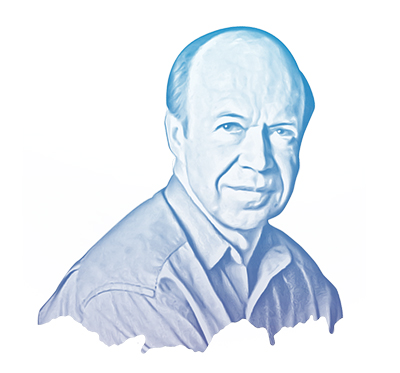
Warning the World
James Hansen, 63BA, 65MS, 67PhD
During an unprecedented national heat wave and drought in the summer of 1988, top NASA climate scientist James Hansen, 63BA, 65MS, 67PhD, appeared at a congressional hearing and delivered an alarming message. Rising global temperatures, according to Hansen's research, were not merely natural fluctuations, but instead caused by the buildup of carbon dioxide and other man-made gases in the atmosphere. "The greenhouse effect has been detected, and it's changing our climate now," he told lawmakers.
Hansen's sense of urgency has only increased in the nearly 30 years since his landmark testimony, which established his reputation as the father of climate change awareness. After retiring from his post at NASA in 2013, Hansen founded the Climate Science, Awareness and Solutions program at Columbia University's Earth Institute and remains one of the most prominent and outspoken figures in his field.
Hansen's 2012 TED talk, which compared global warming to a "giant asteroid on a direct collision course with Earth," has been viewed more than 1.2 million times. He was the subject of a Rolling Stone feature last year in which he warned of a global emergency. And he's at work on his second book, Sophie's Planet, which is named after his granddaughter and maps out what must be done to reverse the climate's course for the next generation.
"When I was young, everything looked bright for the future," says Hansen, who received a Distinguished Alumni Award from his alma mater in 1991. "You could expect to do better than your parents. But, partly due to the deteriorating situation in regard to energy and climate, that's no longer true."
A Denison, Iowa, native and the son of a tenant farmer, Hansen arrived at the UI to study mathematics and physics at the same time renowned researcher James Van Allen, 36MS, 39PhD, was building the U.S.'s early space instruments in the basement of the physics building. As an undergraduate, Hansen was intimidated by Van Allen's towering reputation and avoided his courses. But during his senior year, a professor convinced Hansen to take the physics qualifying exam, and his strong performance caught Van Allen's attention.
Hansen would go on to earn his master's and doctoral degrees under Van Allen, who introduced Hansen to new data from the planet Venus that sparked his interest in planetary atmospheres. After leaving Iowa City for NASA, Hansen proposed an instrument for a mission to Venus to study why the planet is so hot. The cause, it turned out, was the large amount of carbon dioxide in its atmosphere. That raised a question closer to home: With Earth's own CO2 levels rapidly rising because of the burning of coal, oil, and gas, what does that mean for life on our planet?
It's a question that remains at the heart of his research. Earlier this year, Hansen served as the lead author on a paper titled "The Young People's Burden," which concluded that global warming over the past 50 years has raised Earth's temperature to levels last seen in the Eemian period—115,000 years ago—when sea levels were 20 to 30 feet higher than today. The study also found that the aspirational goal of the 2015 Paris climate agreement to keep global warming below 1.5 degrees Celsius is not adequate, and that the notion humanity may have turned a corner toward solving global warming is wrong.
The Earth is approaching a "point of no return," Hansen says, where continued high emissions will lock in warmer ocean temperatures and irreversibly melt the ice shelves around Antarctica and Greenland. He worries that future generations could inherit a problem they have no chance of stopping.
"We may reach a point where that becomes unavoidable, in which case you get a sea level rise of several meters," Hansen says. "We'll lose coastal cities, and the planet will become practically ungovernable because of refugees from low-lying areas and low latitudes that are becoming increasingly hot."
Hansen's science has spurred his activism. In 2015, Hansen and a group of 21 plaintiffs under the age of 21—including his oldest grandchild—filed a lawsuit against the federal government alleging that it has put future generations in significant danger by not taking action to curb carbon pollution. The case remains ongoing.
Hansen also has been a leading advocate for a "carbon fee and dividend" policy to ween the world from fossil fuels. The idea is that the government would collect an incremental fee from fossil fuel companies at the domestic mine or port of entry, then distribute that money equally to households as a monthly energy dividend. The fee would provide powerful incentives for fuel companies to invest in clean energy and consumers to reduce their carbon footprints. Hansen describes it as a conservative approach that allows the market to drive change. At the same time, he says about two-thirds of citizens would benefit because the dividends they receive would be greater than their increased costs for fuel.
"Studies show it would spur the economy and create millions of jobs as we move toward alternative energy," Hansen says of the approach. "There's no cost, and no reason not to do this except that the fossil fuel industry doesn't want us to do it, and they're incredibly powerful." —JOSH O'LEARY

Hansen to visit UI
Climate expert and UI alumnus James Hansen will return to Iowa City in February as part of the university's Climate for Change theme semester. The UI has partnered with Iowa City Darwin Day to bring Hansen to campus to talk with groups Feb. 23-24. Visit iowacitydarwinday.org for more details.
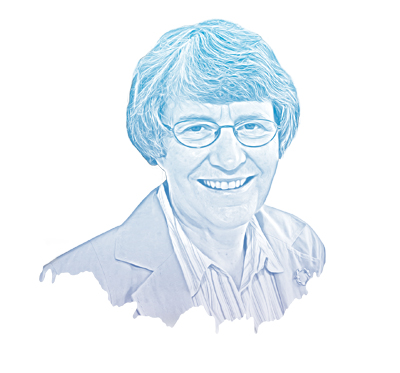
Combating Apathy through Storytelling
Connie Mutel
Retired UI science writer Connie Mutel frequently walks with her grandkids through the oak and hickory woodlands surrounding her home near Iowa City, wondering about the future of the planet they'll inherit.
Will her grandchildren be able to offer their children fond memories of chasing toads, collecting insects, and shuffling through leaves? Or will their backyard paradise become paradise lost?
In her latest book, A Sugar Creek Chronicle: Observing Climate Change from a Midwestern Woodland, Mutel uses family and nature stories to inspire readers to act against climate change for the sake of future generations. As an environmental speaker and author who has penned countless materials for the UI Press and IIHR-Hydroscience & Engineering, Mutel believes waking the general public to the urgency and magnitude of this global crisis will take more than scientific data. "Climate change is such a huge problem, and most people are unaware of it," says Mutel, whose book is part memoir, part nature and climate journal. "Instead of affecting people's minds, your words need to grab them in the gut. And you do that by telling stories."
While scientists have understood the man-made drivers of climate change since before Iowa became a state, Mutel says the United States has not acted upon the threat until more recently. "If we had dealt with climate change in 1989, when our federal legislature was first considering a carbon tax, we could have limited the melting of ice sheets and extreme weather we see now," says Mutel, who was motivated to write her book after editing a 2010 state report on climate change's impact on Iowa. "At that time, we could've pretty much mitigated the problem. Now, nearly 30 years later, levels of greenhouse gases in our atmosphere are significantly higher and more dangerous. We have to adapt to worsening problems, because we can't go backwards at this point."
Already, Mutel says she has seen the destruction of climate change in her life. When she and her husband, UI physics and astronomy professor Robert Mutel, first married, they dreamed of sledging across Greenland. Now rising greenhouse gas emissions and global average temperatures are shooting Greenland's melting ice into sinkholes and out to the ocean. Closer to home, Connie Mutel has noticed increasingly severe heat waves and extreme weather events—affecting Iowa's flora and fauna.
Despite the dire and possibly irreversible consequences of climate change, Mutel always offers hope when speaking to students and community groups about the rapidly changing environment. She explains that switching from fossil fuel to renewable energy will not only lead to cleaner air and water, but also improve health and create more jobs to stimulate the economy. "Dealing with climate change is a win-win situation," she says. "Each action we take is creating a better future for billions of people." —SHELBI THOMAS
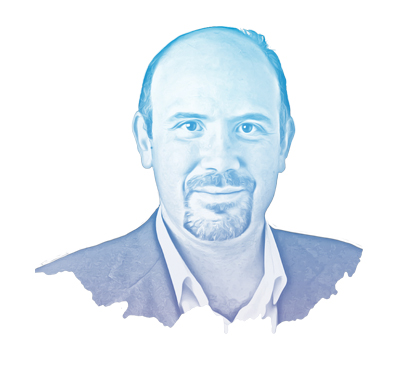
Analyzing Streams of Data
Gabriele Villarini, 08PhD
Gabriele Villarini's career studying extreme weather got off to a wet start.
Villarini—a UI associate professor in civil and environmental engineering, member of the Iowa Flood Center, and interim director of IIHR-Hydroscience & Engineering—earned his Ph.D. at Iowa during the height of the 2008 flood. As rising waters closed campus that summer, he was forced to defend his rainfall-related thesis in the basement of UI engineering professor Witold Krajewski's home. Says Villarini: "That made an everlasting impression on me in terms of how big of an impact a flood can have not just on the environment, but on the livelihood of people and their well-being."
Villarini, 08PhD, now researches past extreme weather events—including the 2008 flood—to help understand their causes and leave communities better prepared for the future. He says that while man-made climate change can't be identified as the cause of a flood or hurricane, it has increased the odds of severe weather. Greenhouse gas emissions warm air, enabling it to hold more moisture and potentially produce heavier rainfalls. Looking at climate records dating back more than a century, Villarini has discovered that the resulting changes in seasonal rainfall and temperature in the Midwest have led to more frequent flooding.
Villarini's research has proved useful for the U.S. Army Corps of Engineers, which must ensure that dams and other structures withstand the test of time, as well as to emergency management planners entrusted to respond to extreme weather. When Cedar Rapids faced the threat of major flooding in fall 2016, the community turned to the UI-based Iowa Flood Center and its resources to prepare. The center has more than doubled the number of sensors placed on bridges in the state's streams and rivers since its creation in 2009, which allowed emergency managers to monitor water levels in real-time. The center's website also provides detailed flood maps for 23 Iowa cities that helped Cedar Rapids officials and residents estimate potential damage for any given neighborhood and rainfall scenario. At one point during the 2016 flood, the site crashed briefly after receiving tens of thousands of hits in a short time frame. Says Villarini: "It was a huge validation that all the efforts we put toward this were well-received and well-utilized."
While it's not easy for scientists to differentiate between natural variability and man-made contributions to the flood and other extreme weather events, Villarini says it's important to start acting against the harmful effects of climate change now. "The notion that we don't know, so we can't do—it's a little shortsighted in the sense that we still have to make a decision today," says Villarini. "The clock is ticking, and there is a sense of urgency. Maybe instead of trying to change the present, we'll have to adapt to a different future." —SHELBI THOMAS
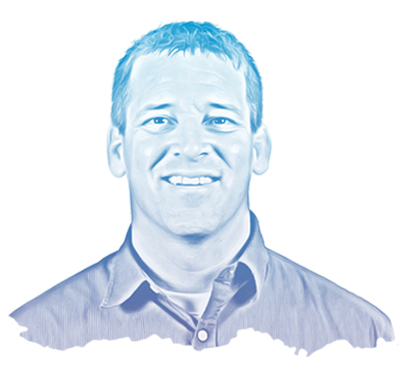
Sparking Classroom Curiosity
Ted Neal, 00IED, 17PhD
As both a parent and college instructor, Ted Neal is alarmed by the number of students who tell him they hate science.
"What they truly don't like is how science is taught," says the UI clinical associate professor of education. "Nobody likes memorizing a bunch of formulas and filling out worksheets, but every single kid I've ever met is curious, and if you can work with the curiosity that a person innately has, that's when they learn science."
Neal, 00IED, 17PhD, ignites students' passion for learning about climate change and other scientific topics by training middle and high school teachers in the Next Generation Science Standards. Approved by the Iowa State Board of Education in August 2015, the NGSS is a national effort to revamp science education through a teaching method that emphasizes critical thinking and hands-on investigation. The standards—developed by education experts in 26 states—will be fully implemented in Iowa's K-12 classrooms by the 2018-19 school year.
Though adapting to the NGSS style can be challenging for teachers, Neal's research shows that students from all backgrounds and learning abilities do significantly better in the classroom when using this method. "We have to help teachers to shift from being the knower of knowledge and to instead become facilitators of learning," he says of the new inquiry-based approach.
To help eighth-grade teachers address climate change in their classrooms, Neal and other UI scientists at the College of Education and Center for Global and Regional Environmental Research are developing a free online textbook with resources and lesson plans. Neal's studies show that many teachers lack the confidence to teach the pressing issue, whether due to limited knowledge of the topic or its controversial nature. The NGSS approach allows students to raise their own questions about climate change, study data such as rising temperatures and the frequency of rainfall events over time, and come to an informed conclusion.
Through the process, students speak with their grandparents about environmental differences they've observed over their lifetimes, learn how to analyze statistics on CO2 outputs and rising sea levels, and determine what personal and national changes could have a positive impact. "My hope is to figure out how to help kids become interested in solving the problems of the future," says Neal. "If you don't have a planet to live on, does anything else matter?" —SHELBI THOMAS
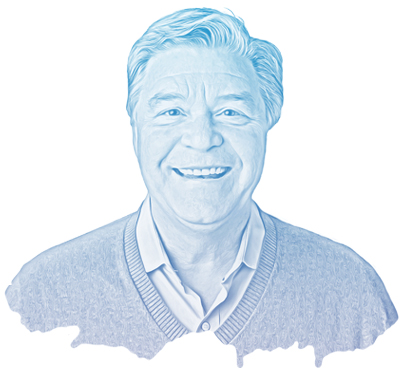
Moving Forward After Paris
Jerry Schnoor
In 2015, University of Iowa professor Jerry Schnoor and three graduate students traveled to Paris for a historic United Nations summit on climate change. On hand to report on issues relevant to Iowans, the UI contingent heard from small coastal nations battered by increasingly powerful tropical storms and developing countries suffering from droughts and famine. The result of the 12-day conference, which brought together nearly 40,000 stakeholders from 195 nations, was the Paris climate agreement, an international pact to cut greenhouse gases and help poor countries grappling with global warming.
Two years later, the political winds have shifted. The White House wants the U.S. to pull out of the accord, citing unfair standards on American businesses and workers. The Environmental Protection Agency removed climate change information from parts of its website earlier this year. And Schnoor, an environmental engineering professor, says some researchers have had to eschew the term "climate change" in their work to better compete for funding.
"They're actually doing the same research but are expressing it in terms of 'extreme events' or 'changes in weather patterns,'" says Schnoor, co-director of the UI-based Center for Global and Regional Environmental Research. "So the semantics have changed a bit, but no one has really changed the nature of their research because we think it's really important."
Evidence of climate change becomes clearer by the year, says Schnoor. When he and engineering professor Greg Carmichael founded CGRER in 1990 in response to Iowa lawmakers' calls for a state global warming center, scientists were just beginning to warn of a bleak environmental future. Today, ice is breaking away from continental glaciers. Oceans are 30 percent more acidic than a half century ago. And sea levels are on the rise, with coastal cities like Miami seeing a greater number of days of high-tide flooding.
"We're talking about evidence from space, land-based evidence, evidence from the ocean, from fossils, from ice cores going back 700,000 years," Schnoor says. "It's just massive. And it all points to the same conclusion: It's getting warmer, without a doubt, and there's more extreme events, without a doubt. And it's due to us."
In its 27 years, CGRER has grown to include 128 members from the UI and 13 other institutions who study human-induced environmental change in Iowa and beyond. CGRER collaborators include associate geography professor Eric Tate, who is researching the sustainability of rainwater harvesting systems in India; associate professor Charles Stanier, who is working with the City of Dubuque to improve its air quality; and associate chemistry professor Betsy Stone, who has organized the Iowa Climate Festival.
Earlier this year, Schnoor was among the 190 faculty and researchers from 39 Iowa colleges and universities who signed CGRER's annual climate statement, which highlights a rarely discussed aspect of climate change: rising humidity. Since 1971, Iowa's cities have seen a dramatic increase in humidity levels, including an 11.9 percent spike in Des Moines and a 22.2 percent leap in Cedar Rapids. Schnoor says increased air moisture leads to more extreme rain events, among a host of other agricultural, human health, and economic problems.
The dramatic flooding seen in Iowa in recent years—including the widespread 2008 disaster that devastated parts of the UI campus—is symptomatic of what's to come. The computer models Schnoor studies with his students generally show the state being warmer and wetter in 50 years, meaning more extreme rain events and flooding. At the same time, Iowa's climate will be punctuated with more frequent droughts.
Schnoor says the Paris climate agreement isn't perfect, and its goal of keeping global temperatures from rising more than 3.6 degrees above pre-industrial levels doesn't go far enough to stem the tide of climate change. But he says for the U.S. to back out would be a blow to the nation's credibility as a world leader. "It's an economic opportunity to respond to climate change," Schnoor says. "We'll save money in the long run, we'll create jobs, and it'll be the engine for economic improvement in the future. It would be a shame to let other nations seize the day." — JOSH O'LEARY
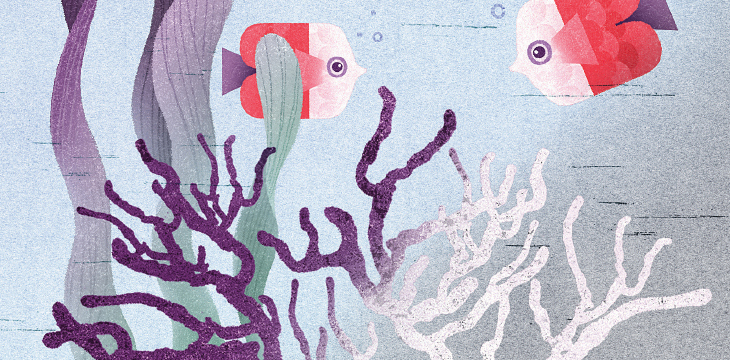

Into the deep
Ted Waitt
Earth's five oceans cover 71 percent of its surface and compose 99 percent of its livable space. They shape the weather, regulate temperature, and produce 70 percent of the planet's oxygen, while also providing food and job security for billions of people.
Oceans are crucial to humans' survival—yet many experts say we've brought them to the brink of catastrophe.
One international study from a 2015 issue of the journal Science warned that oceans are on the verge of "a major extinction event." And a 2017 report from UNESCO cautioned that, without a reduction in carbon emissions, most coral reef systems will be dead by 2100.
Dire predictions such as these are what launched Sioux City native Ted Waitt, 17LHD, on an ocean conservation crusade. The former UI student and Fortune 500 "maverick," who co-founded Gateway 2000, gave a university talk about philanthropy last year and explained his Waitt Foundation's efforts to save the oceans.
During his lecture, Waitt—who has visited 100 countries, five oceans, and seven continents—said: "After I retired, I was traveling the world...doing ocean exploration. Then I started talking to more scientists and discovered that it really is one of the biggest problems of our time, how we've decimated the oceans. But it's fixable. We can do things to adapt and make a difference."
The Waitt Foundation funds those fixes. It invests in international initiatives aimed at mitigating the effects of overfishing, pollution, and climate change—and restoring our oceans to full productivity. The foundation's Waitt Institute is making that happen in places such as the Kingdom of Tonga, Montserrat, Curaçao, and Barbuda, which recently was decimated by Hurricane Irma, a cataclysmic storm fueled by warm waters.
Barbuda, a small Caribbean island of about 1,600 people, began collaborating with the institute in 2013, passing regulations for fishery management and designating 30 percent of its marine environment as protected areas that prohibit fishing. "We were really far along with our efforts in Barbuda," says Kathryn Mengerink, executive director of the institute, a nonprofit organization that partners with island governments and communities to restore coral reefs and fisheries. "But Hurricane Irma was a game changer there, and Mr. Waitt wanted to immediately move forward with hurricane relief."
That means that the institute—which usually works with coastal residents to craft policy changes, educate future generations, and implement new practices—now is, as Mengerink says, "one actor in a group of actors helping to support Barbuda's recovery."
Such efforts all are part of the institute's broader vision for empowering people to restore the oceans. And though coral reefs continue to die from bleaching events, and fertilizer runoff in the Gulf of Mexico created an oxygen-depleted "dead zone" the size of New Jersey this year, Mengerink remains convinced that there's hope.
"I'm a perpetual optimist, which is how I can do this job," she says. "People have caused this problem, but we can change our behavior. We can support improved practices and minimize our footprint. We can help our oceans recover." —LEAH KLEVAR

